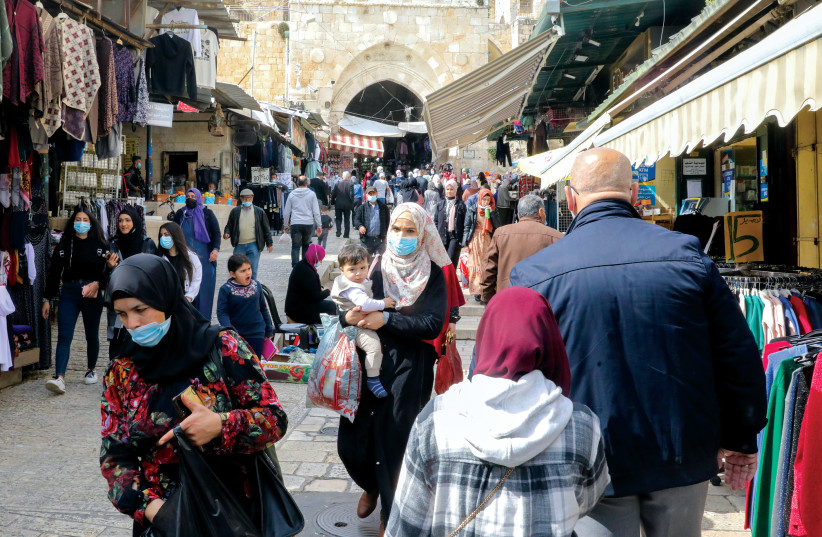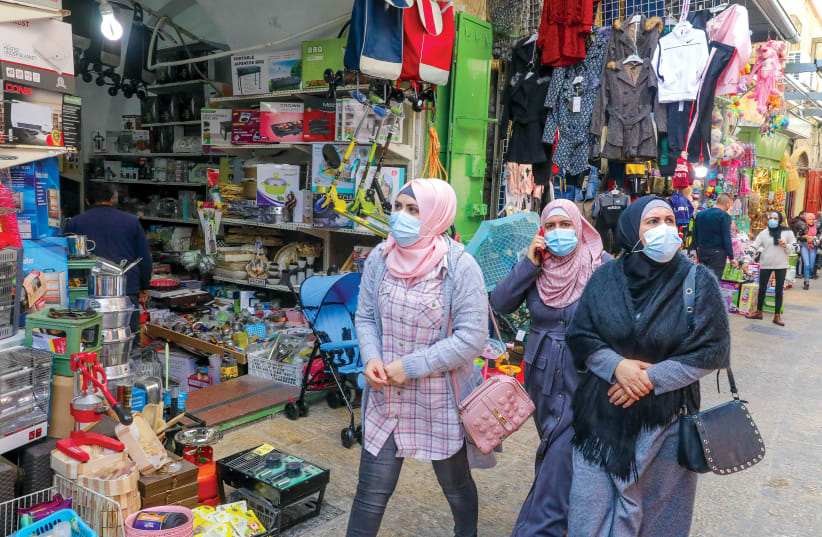Jerusalem Arabs were 70,000 on the eve of the Six Day War (according to a Jordanian Census done in 1966) and today, they are about 380,000, while some 120,000 live in the neighborhoods under Jerusalem Municipality Urban jurisdiction, but beyond the security fence. Their status is as residents but not citizens, although there is a steady upward trend in applications for citizenship, especially among educated young Arabs.
As residents, they are entitled to all the social rights granted by Israel, but they are prevented from participating in Knesset elections, and the danger always prevails that they will lose their eligibility for resident status if they are absent from the city for a period exceeding one year. These social services include health insurance, National Insurance benefits, education, municipal services and the like.
But who are the Arabs of Jerusalem? Are they a unified and united society or are they made up of different groups with different and sometimes even contradictory affiliations and loyalties?
In Jerusalem is launching a series depicting the Arab sector of the city, in order to describe the complexity of this society. What is common to all, Muslims and Christians, what separates different groups, what they suffer from and what bothers them the most. Do they have a uniform identity or are there differences between the generations, family affiliations and more.
SCHOLARS AND researchers point out that the Palestinian sector in Jerusalem is a divided and complex society that forms a kind of mosaic of belongings, which are sometimes hostile to each other or at least competing for influence in Palestinian society in the east of the city.


Prof. Itzhak Reiter, an expert on Islam and Middle East at the Ashkelon Academic College who researched Palestinian society in the east of the city for many years, says that what appears at first glance is the Israelization process of the Jerusalemite Palestinian society.
“For quite many, the understanding is that the conflict (over Jerusalem) is over. The understanding is that we have conquered them completely and we are doing now what we want in Jerusalem. I’m sure that inside the Israeli establishment many think that we have brought them to the position of being Israelis.
“In fact, they are already Israelis in many ways and while it does not mean that they like the fact that they are under Israeli sovereignty, they understand that they don’t have many alternatives.”
Reiter adds that this is why Arabs of Jerusalem, especially among the young generation, increasingly want to learn Hebrew and want to integrate into the Israeli employment market, which they understand will mainly be in the west of the city.
Jerusalem Arabs often define themselves as orphans and Reitter agrees that this is indeed the definition that suits their situation, but adds that it is not necessarily a bad situation in their eyes, because they have the option today to be orphans and yet enjoy several options.
“I would say that they want to be orphans, because on one hand they do not want to live under Israeli rule only, but they also do not want to live under the Palestinian Authority (PA) because of the corruption and violence existing there, so they try to be in a situation where they can enjoy all worlds. They did not give up their national identity, but the practical steps, like living in reasonable conditions and living a normal life are accessible through what Israel gives them.”
Reiter explains that there are several distinctions between the different parts of the Arab society of the city. One distinction is the social origin of a group, “considering that about 50% of the present Arab residents of Jerusalem originally come from Hebron and are perceived as those who took over and developed their careers at the expense of the old locals, like the Nusseibeh, the Nashibshi and the El Khatib families and more. Until 1967, there was a very tough competition between the locals and the Hebronites, a trend that started during the Jordanian rule, but intensified after 1967.”
ANOTHER GROUP was formed by the Israeli Arabs who moved to Jerusalem from the Arab villages in the Galilee. These are highly educated people, but in the eyes of the local Arabs, they are perceived as those who occupy all the good jobs in the city at their expense. Interestingly, they will not present themselves as Israelis, but as Arabs from the North, thereby expressing the complexity of their status – on the one hand Arabs with Palestinian identity and on the other hand, with Israeli citizenship – which puts them in a more comfortable place and much more likely to win important positions in the city.
However, the primary division is evidently the religious one, between Christians and Muslims, with the Christian community shrinking along the years, now standing at merely 13,000 original Jerusalemites, with some 2000 Christian establishment members and clergy on top. As well, there is a geographical distinction by residential areas.
On one hand there are neighborhoods like Beit Hanina and Shuafat, (not to be confused with the refugee camps of the same name) inhabited by Christians and Muslims with high socio-economic status, with prestigious schools (mostly attended by Muslim children from high socio-economic backgrounds), while other neighborhoods, like those in the south of the city, such as Sur Bahir, Um-Lison and Ras el-Amud are inhabited by Arabs of rural and tribal origins. In the north of the city, in Issawiyeh, part of Silwan, Wadi Joz and Sheikh Jarrah, are found the economic elites of the city.
BUT EVEN inside the Muslim population of the city there are some significant distinctions, such as the Sufis, a rather large group identified with a mystical approach to Islam and very moderate politically. On the other side, there are the Salafists, much more extremists both in religious and political terms. In between, there are those identified with Hamas, which is quite strong in east Jerusalem, and of course, those identified with Fatah and small part supporters of the Popular Front.
Asked what is most troubling to the residents of the east of the city in their daily lives, Reiter says that first of all the concerns is about the status of Al-Aqsa Mosque and immediately afterward the lack of building permits and house demolitions that deprives them of the opportunity to lead a reasonable life. Reiter adds that right after these issues, the almost daily friction with border guards, the lack of empathy for their situation from the Israeli establishment and the settlers are high in the list of the Arab residents’ concerns. “The fear of having their properties being taken over by settlers is, for the residents of the east of the city, at the level of existential anxiety,” concluded Reiter.
As for the change in the economic policy of the government, namely the NIS 2.5 billion approved by the government in 2017 and soon to be continued with another five-year budget approved with about the same sum. Reiter confirms that the changes on the ground due to that budget are not disregarded; however, asked if this is significant for them, he says, “Where you see the change they might say it is a drop in the ocean. But it has added some different perspectives, like internalizing that by investing such sums, Israel in fact says loud and clear that it will never get out of east Jerusalem. I think they understand that and with all the problems, the friction with the police and the settlers, still their freedom here is wider than under the PA or in Gaza.”
This is the first in a series of articles.
